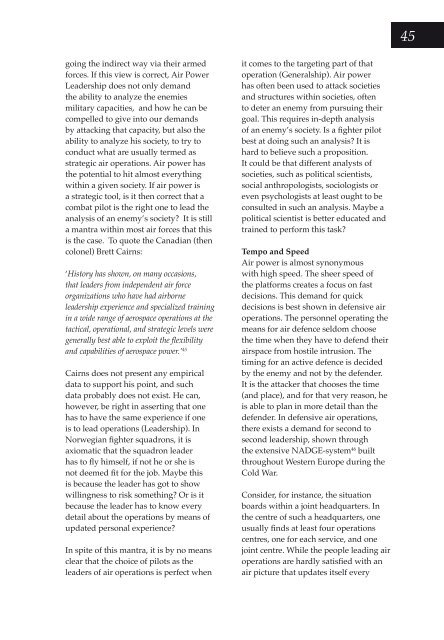REVIEW - Royal Air Force Centre for Air Power Studies
REVIEW - Royal Air Force Centre for Air Power Studies
REVIEW - Royal Air Force Centre for Air Power Studies
Create successful ePaper yourself
Turn your PDF publications into a flip-book with our unique Google optimized e-Paper software.
going the indirect way via their armed<br />
<strong>for</strong>ces. If this view is correct, <strong>Air</strong> <strong>Power</strong><br />
Leadership does not only demand<br />
the ability to analyze the enemies<br />
military capacities, and how he can be<br />
compelled to give into our demands<br />
by attacking that capacity, but also the<br />
ability to analyze his society, to try to<br />
conduct what are usually termed as<br />
strategic air operations. <strong>Air</strong> power has<br />
the potential to hit almost everything<br />
within a given society. If air power is<br />
a strategic tool, is it then correct that a<br />
combat pilot is the right one to lead the<br />
analysis of an enemy’s society? It is still<br />
a mantra within most air <strong>for</strong>ces that this<br />
is the case. To quote the Canadian (then<br />
colonel) Brett Cairns:<br />
‘History has shown, on many occasions,<br />
that leaders from independent air <strong>for</strong>ce<br />
organizations who have had airborne<br />
leadership experience and specialized training<br />
in a wide range of aerospace operations at the<br />
tactical, operational, and strategic levels were<br />
generally best able to exploit the flexibility<br />
and capabilities of aerospace power.’ 45<br />
Cairns does not present any empirical<br />
data to support his point, and such<br />
data probably does not exist. He can,<br />
however, be right in asserting that one<br />
has to have the same experience if one<br />
is to lead operations (Leadership). In<br />
Norwegian fighter squadrons, it is<br />
axiomatic that the squadron leader<br />
has to fly himself, if not he or she is<br />
not deemed fit <strong>for</strong> the job. Maybe this<br />
is because the leader has got to show<br />
willingness to risk something? Or is it<br />
because the leader has to know every<br />
detail about the operations by means of<br />
updated personal experience?<br />
In spite of this mantra, it is by no means<br />
clear that the choice of pilots as the<br />
leaders of air operations is perfect when<br />
it comes to the targeting part of that<br />
operation (Generalship). <strong>Air</strong> power<br />
has often been used to attack societies<br />
and structures within societies, often<br />
to deter an enemy from pursuing their<br />
goal. This requires in-depth analysis<br />
of an enemy’s society. Is a fighter pilot<br />
best at doing such an analysis? It is<br />
hard to believe such a proposition.<br />
It could be that different analysts of<br />
societies, such as political scientists,<br />
social anthropologists, sociologists or<br />
even psychologists at least ought to be<br />
consulted in such an analysis. Maybe a<br />
political scientist is better educated and<br />
trained to per<strong>for</strong>m this task?<br />
Tempo and Speed<br />
<strong>Air</strong> power is almost synonymous<br />
with high speed. The sheer speed of<br />
the plat<strong>for</strong>ms creates a focus on fast<br />
decisions. This demand <strong>for</strong> quick<br />
decisions is best shown in defensive air<br />
operations. The personnel operating the<br />
means <strong>for</strong> air defence seldom choose<br />
the time when they have to defend their<br />
airspace from hostile intrusion. The<br />
timing <strong>for</strong> an active defence is decided<br />
by the enemy and not by the defender.<br />
It is the attacker that chooses the time<br />
(and place), and <strong>for</strong> that very reason, he<br />
is able to plan in more detail than the<br />
defender. In defensive air operations,<br />
there exists a demand <strong>for</strong> second to<br />
second leadership, shown through<br />
the extensive NADGE-system 46 built<br />
throughout Western Europe during the<br />
Cold War.<br />
Consider, <strong>for</strong> instance, the situation<br />
boards within a joint headquarters. In<br />
the centre of such a headquarters, one<br />
usually finds at least four operations<br />
centres, one <strong>for</strong> each service, and one<br />
joint centre. While the people leading air<br />
operations are hardly satisfied with an<br />
air picture that updates itself every<br />
45

















